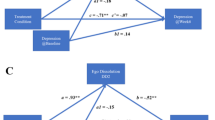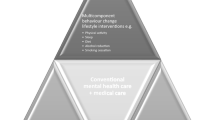Abstract
Viral suppression, a critical component of HIV care, is more likely when individuals initiate antiretroviral therapy (ART) early in disease progression and maintain optimal levels of adherence to ART regimens. Although several studies have documented the negative association of depressive symptoms with ART adherence, less is known about how depressed mood relates to intentional versus unintentional lapses in adherence as well as the mechanisms underlying this association. The purpose of the current study was to examine the association of depressive symptoms with ART adherence, assessed as a multidimensional construct. Secondarily, this study conducted preliminary indirect path models to determine if medication self-efficacy could explain the depressed mood-adherence relationship. Depressive symptoms were not associated with 95% ART taken, self-reported viral load, deliberate adjustments to ART regimens or skipped ART doses. However, the indirect association of depressive symptoms via decrements in medication self-efficacy was significant for 95% ART taken, self-reported viral load and skipped ART doses, but not deliberate changes to ART regimens. In this sample of HIV-positive outpatients, there is evidence to support medication self-efficacy as a potential mechanism underlying the association between depressive symptoms and ART adherence. Additional longitudinal studies are needed to formally examine medication taking self-efficacy as a mediator.

Similar content being viewed by others
Change history
31 May 2018
The original version of this article unfortunately contained a mistake in Fig. 1. The figure was incorrectly presented with the results of an additional path model for forgotten antiretroviral therapy (ART) doses that was dropped from the primary analyses.
Notes
Neither depressive symptoms or medication self-efficacy were associated with AUDIT scores in the bivariate analyses.
References
CDC. Diagnoses of HIV Infection in the United States and Dependent Areas, 2014. HIV Surveillance Report 2015. 2016;26.
Cohen MS, Chen YQ, McCauley M, et al. Prevention of HIV-1 infection with early antiretroviral therapy. N Engl J Med. 2011;365(6):493–505.
Rodger AJ, Cambiano V, Bruun T, et al. Sexual activity without condoms and risk of HIV transmission in serodifferent couples when the HIV-positive partner is using suppressive antiretroviral therapy. JAMA. 2016;316(2):171–81.
Dieffenbach CW, Fauci AS. Universal voluntary testing and treatment for prevention of HIV transmission. JAMA. 2009;301(22):2380–2.
Dodd PJ, Garnett GP, Hallett TB. Examining the promise of HIV elimination by ‘test and treat’ in hyperendemic settings. AIDS (London, England). 2010;24(5):729–35.
Granich RM, Gilks CF, Dye C, De Cock KM, Williams BG. Universal voluntary HIV testing with immediate antiretroviral therapy as a strategy for elimination of HIV transmission: a mathematical model. Lancet (London, England). 2009;373(9657):48–57.
Kalichman SC, Cherry C, Amaral CM, et al. Adherence to antiretroviral therapy and HIV transmission risks: implications for test-and-treat approaches to HIV prevention. AIDS Patient Care STDs. 2010;24(5):271–7.
Ickovics JR, Cameron A, Zackin R, et al. Consequences and determinants of adherence to antiretroviral medication: results from Adult AIDS Clinical Trials Group protocol 370. Antivir Ther. 2002;7(3):185–93.
Mannheimer S, Friedland G, Matts J, Child C, Chesney M. The consistency of adherence to antiretroviral therapy predicts biologic outcomes for human immunodeficiency virus-infected persons in clinical trials. Clin Infect Dis. 2002;34(8):1115–21.
McNabb J, Ross JW, Abriola K, Turley C, Nightingale CH, Nicolau DP. Adherence to highly active antiretroviral therapy predicts virologic outcome at an inner-city human immunodeficiency virus clinic. Clin Infect Dis. 2001;33(5):700–5.
Langebeek N, Gisolf EH, Reiss P, et al. Predictors and correlates of adherence to combination antiretroviral therapy (ART) for chronic HIV infection: a meta-analysis. BMC Med. 2014;12:142.
Gonzalez JS, Batchelder AW, Psaros C, Safren SA. Depression and HIV/AIDS treatment nonadherence: a review and meta-analysis. J Acquir Immune Defic Syndr (1999). 2011;58(2):181–7.
Markowitz JC, Rabkin JG, Perry SW. Treating depression in HIV-positive patients. AIDS (London, England). 1994;8(4):403–12.
Bing EG, Burnam MA, Longshore D, et al. Psychiatric disorders and drug use among human immunodeficiency virus-infected adults in the United States. Arch Gen Psychiatry. 2001;58(8):721–8.
Ciesla JA, Roberts JE. Meta-analysis of the relationship between HIV infection and risk for depressive disorders. Am J Psychiatry. 2001;158(5):725–30.
Onken LS, Carroll KM, Shoham V, Cuthbert BN, Riddle M. Reenvisioning clinical science: unifying the discipline to improve the public health. Clin Psychol Sci. 2014;2(1):22–34.
Kennedy SH. Core symptoms of major depressive disorder: relevance to diagnosis and treatment. Dialogues Clin Neurosci. 2008;10(3):271–7.
Bandura A. Social foundations of thought and action: a social cognitive theory. Englewood Cliffs: Prentice-Hall, Inc; 1986.
Houston E, Mikrut C, Guy A, et al. Another look at depressive symptoms and antiretroviral therapy adherence: the role of treatment self-efficacy. J Health Psychol. 2016;21(10):2138–47.
Nokes K, Johnson MO, Webel A, et al. Focus on increasing treatment self-efficacy to improve human immunodeficiency virus treatment adherence. J Nurs Scholarsh. 2012;44(4):403–10.
Tyer-Viola LA, Corless IB, Webel A, Reid P, Sullivan KM, Nichols P. Predictors of medication adherence among HIV women in North America. J Obstet Gynecol Neonatal Nurs. 2014;43(2):168–78.
Cha E, Erlen JA, Kim KH, Sereika SM, Caruthers D. Mediating roles of medication-taking self-efficacy and depressive symptoms on self-reported medication adherence in persons with HIV: a questionnaire survey. Int J Nurs Stud. 2008;45(8):1175–84.
Archiopoli A, Ginossar T, Wilcox B, Avila M, Hill R, Oetzel J. Factors of interpersonal communication and behavioral health on medication self-efficacy and medication adherence. AIDS Care. 2016;28(12):1607–14.
Tatum AK, Houston E. Examining the interplay between depression, motivation, and antiretroviral therapy adherence: a social cognitive approach. AIDS Care. 2017;29(3):306–10.
Kekwaletswe CT, Jordaan E, Nkosi S, Morojele NK. Social support and the mediating roles of alcohol use and adherence self-efficacy on antiretroviral therapy (ART) adherence among ART recipients in Gauteng. South Africa. AIDS Behav. 2017;21(7):1846–56.
Lehane E, McCarthy G. Intentional and unintentional medication non-adherence: a comprehensive framework for clinical research and practice? A discussion paper. Int J Nurs Stud. 2007;44(8):1468–77.
Wroe AL. Intentional and unintentional nonadherence: a study of decision making. J Behav Med. 2002;25(4):355–72.
Mo PK, Mak WW. Intentionality of medication non-adherence among individuals living with HIV/AIDS in Hong Kong. AIDS Care. 2009;21(6):785–95.
Levy RW, Rayner CR, Fairley CK, et al. Multidisciplinary HIV adherence intervention: a randomized study. AIDS Patient Care STDS. 2004;18(12):728–35.
Sweeney SM. Understanding mediators of the relationship between HIV-related stigma and medication adherence among people living with HIV. Dissertations - ALL. 2016;665.
Saunders JB, Aasland OG, Babor TF, de la Fuente JR, Grant M. Development of the Alcohol Use Disorders Identification Test (AUDIT): WHO collaborative project on early detection of persons with harmful alcohol consumption–II. Addiction. 1993;88(6):791–804.
Radloff LS. The CES-D scale: a self report depression scale for research in the general population. Appl Psychol Meas. 1977;1:385–401.
Reisner SL, Mimiaga MJ, Skeer M, et al. Clinically significant depressive symptoms as a risk factor for HIV infection among black MSM in Massachusetts. AIDS Behav. 2009;13(4):798–810.
Johnson MO, Neilands TB, Dilworth SE, Morin SF, Remien RH, Chesney MA. The role of self-efficacy in HIV treatment adherence: validation of the HIV treatment adherence self-efficacy scale (HIV-ASES). J Behav Med. 2007;30(5):359–70.
Simoni JM, Kurth AE, Pearson CR, Pantalone DW, Merrill JO, Frick PA. Self-report measures of antiretroviral therapy adherence: a review with recommendations for HIV research and clinical management. AIDS Behav. 2006;10(3):227–45.
Giordano TP, Guzman D, Clark R, Charlebois ED, Bangsberg DR. Measuring adherence to antiretroviral therapy in a diverse population using a visual analogue scale. HIV Clin Trials. 2004;5(2):74–9.
Kalichman SC, Rompa D, Cage M. Reliability and validity of self-reported CD4 lymphocyte count and viral load test results in people living with HIV/AIDS. Int J STD AIDS. 2000;11(9):579–85.
Sewell J, Daskalopoulou M, Nakagawa F, et al. Accuracy of self-report of HIV viral load among people with HIV on antiretroviral treatment. HIV Med. 2016.
Voss JG, Cesan A, Jensen K, et al. Agreement between self-reported knowledge and medical record data. Clin Nurs Res. 2015;24(3):318–36.
Tabachnick BG, Fidell LS. Using multivariate statistics. 5th ed. Boston: Allyn & Bacon/Pearson Education; 2007.
Kim HY. Statistical notes for clinical researchers: evaluation of measurement error 1: using intraclass correlation coefficients. Restor Dent Endod. 2013;38(2):98–102.
Paterson DL, Swindells S, Mohr J, et al. Adherence to protease inhibitor therapy and outcomes in patients with HIV infection. Ann Intern Med. 2000;133(1):21–30.
Beer L, Skarbinski J. Adherence to antiretroviral therapy among HIV-infected adults in the United States. AIDS Educ Prev. 2014;26(6):521–37.
Sullivan LE, Saitz R, Cheng DM, Libman H, Nunes D, Samet JH. The impact of alcohol use on depressive symptoms in human immunodeficiency virus-infected patients. Addiction (Abingdon, England). 2008;103(9):1461–7.
Hendershot CS, Stoner SA, Pantalone DW, Simoni JM. Alcohol use and antiretroviral adherence: Review and meta-analysis. J Acquir Immune Defic Syndr. 2009;52(2):180.
Hayes AF. Introduction to mediation, moderation, and conditional process analysis: a regression-based approach. New York: Guilford Press; 2013.
Preacher KJ, Hayes AF. Asymptotic and resampling strategies for assessing and comparing indirect effects in multiple mediator models. Behav Res Methods. 2008;40(3):879–91.
Baron RM, Kenny DA. The moderator-mediator variable distinction in social psychological research: conceptual, strategic, and statistical considerations. J Pers Soc Psychol. 1986;51(6):1173–82.
Uthman OA, Magidson JF, Safren SA, Nachega JB. Depression and adherence to antiretroviral therapy in low-, middle- and high-income countries: a systematic review and meta-analysis. Curr HIV/AIDS Rep. 2014;11(3):291–307.
Arnsten JH, Demas PA, Farzadegan H, et al. Antiretroviral therapy adherence and viral suppression in HIV-infected drug users: comparison of self-report and electronic monitoring. Clin Infect Dis. 2001;33(8):1417–23.
Wagner G, Miller LG. Is the influence of social desirability on patients’ self-reported adherence overrated? J Acquir Immune Defic Syndr. (1999). 2004;35(2):203–4.
Gandhi M, Ameli N, Bacchetti P, et al. Atazanavir concentration in hair is the strongest predictor of outcomes on antiretroviral therapy. Clin Infect Dis. 2011;52(10):1267–75.
Hickey MD, Salmen CR, Tessler RA, et al. Antiretroviral concentrations in small hair samples as a feasible marker of adherence in rural Kenya. J Acquir Immune Defic Syndr. (1999). 2014;66(3):311–5.
Milam J, Richardson JL, McCutchan A, et al. Effect of a brief antiretroviral adherence intervention delivered by HIV care providers. J Acquir Immune Defic Syndr. 2005;40(3):356–63.
Johnson MO, Charlebois E, Morin SF, Remien RH, Chesney MA. The NHLPT. Effects of a behavioral intervention on antiretroviral medication adherence among people living with HIV: The Healthy Living Project randomized controlled study. J Acquir Immune Defic Syndr. (1999). 2007;46(5):574–80.
Funding
There is no associated funding for this study.
Author information
Authors and Affiliations
Corresponding author
Ethics declarations
Conflict of interest
All authors declare that they have no conflict of interest.
Ethical Approval
All procedures performed in studies involving human participants were in accordance with the ethical standards of the institutional research committee and with the 1964 Helsinki declaration and its later amendments or comparable ethical standards.
Informed Consent
Informed consent was obtained from all individual participants included in the study.
Rights and permissions
About this article
Cite this article
Babowitch, J.D., Sheinfil, A.Z., Woolf-King, S.E. et al. Association of Depressive Symptoms with Lapses in Antiretroviral Medication Adherence Among People Living with HIV: A Test of an Indirect Pathway. AIDS Behav 22, 3166–3174 (2018). https://doi.org/10.1007/s10461-018-2098-1
Published:
Issue Date:
DOI: https://doi.org/10.1007/s10461-018-2098-1




